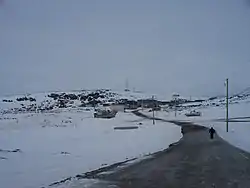Quaqtaq
Quaqtaq (Inuktitut: ᖁᐊᕐᑕᖅ) is a northern village (Inuit community) in Nunavik, northern Quebec, Canada. Its population was 403 in the Canada 2016 Census.
Quaqtaq
ᖁᐊᕐᑕᖅ | |
|---|---|
 | |
 Quaqtaq | |
| Coordinates: 61°02′N 69°37′W[1] | |
| Country | |
| Province | |
| Region | Nord-du-Québec |
| TE | Kativik |
| Constituted | November 1, 1980 |
| Government | |
| • Mayor | Eva Deer |
| • Federal riding | Abitibi—Baie-James—Nunavik—Eeyou |
| • Prov. riding | Ungava |
| Area | |
| • Total | 26.60 km2 (10.27 sq mi) |
| • Land | 26.54 km2 (10.25 sq mi) |
| Population (2016)[4] | |
| • Total | 403 |
| • Density | 15.3/km2 (40/sq mi) |
| • Change (2011–16) | |
| • Dwellings | 137 |
| Time zone | UTC−5 (EST) |
| • Summer (DST) | UTC−4 (EDT) |
| Postal code(s) | J0M 1J0 |
| Area code(s) | 819 |
| Website | www |
The village is one of the northernmost inhabited places in Quebec, located on the eastern shore of Diana Bay (Tuvaaluk in the Inuktitut language), on a peninsula which protrudes into the Hudson Strait where it meets Ungava Bay.[5]
The name Quaqtaq signifies tapeworm. According to local folklore, this name derives from a man who once came to the area to hunt beluga and found live parasites in his feces. His hunting companions began to call the place Quaqtaq.
Inaccessible by road, Quaqtaq is served by the small Quaqtaq Airport.
History
Archaeological evidence indicates that people have occupied the area around Quaqtaq for about 3500 years. Thule people, the ancestors of today's Inuit, arrived around 1400 or 1500 AD.
In 1947, a Roman Catholic mission opened in Quaqtaq. The present-day settlement was established after a trading post first established in 1927 at Iggiajaaq, a few kilometres south-west, was finally closed in 1950. After a measles epidemic killed 11 adults in 1952, the Canadian government began delivering basic services to the community. A nursing station was built in 1963. In the 1960s, the Quebec government opened a store and a post office equipped with a radio-telephone. In 1974, the store became a co-operative and, in 1978, Quaqtaq was legally established as a Northern village.
Since 1996, policing is provided by the Kativik Regional Police Force.[6]
Education
The Kativik School Board operates the Isummasaqvik School.[7]
People
Notable people from the community include musicians Beatrice Deer and Jaaji Uppik.
References
- Reference number 98666 of the Commission de toponymie du Québec (in French)
- Geographic code 99115 in the official Répertoire des municipalités (in French)
- "(Code 2499115) Census Profile". 2011 census. Statistics Canada. 2012.
- https://www12.statcan.gc.ca/census-recensement/2016/dp-pd/prof/details/page.cfm?Lang=E&Geo1=CSD&Code1=2499115&Geo2=CD&Code2=2499&Data=Count&SearchText=Quaqtaq&SearchType=Begins&SearchPR=01&B1=All&TABID=1
- Dorais, Louis-Jacques (1997). Quaqtaq: Modernity and Identity in an Inuit Community. Toronto: University of Toronto Press. p. 132. ISBN 0-8020-7952-0.
- KRPF. "General Information". Home. Retrieved 2017-07-03.
- "Our Schools." Kativik School Board. Retrieved on September 23, 2017.
